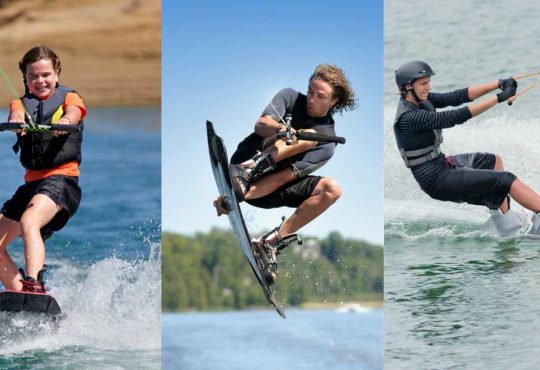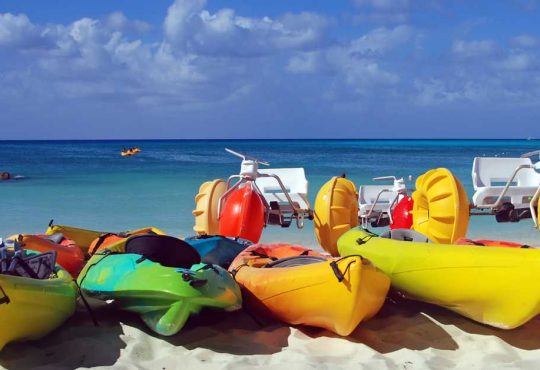Summer is the perfect time to get outside and enjoy the sunshine. Whether you’re looking to stay active, have fun, or just soak in the great outdoors, there’s an outdoor sport for everyone. From thrilling water activities to leisurely hikes, summer outdoor sports offer something for all ages and skill levels. Ready to dive into a season of adventure? Let’s explore the top 10 outdoor sports you should try this summer!
With the long days and warm weather, summer is the ideal season to break away from indoor routines and embrace the natural world. Outdoor sports not only provide a fantastic way to stay fit, but they also offer a chance to connect with nature, friends, and family. So, put on your sunscreen, grab your gear, and let’s discover the best ways to make the most of this sunny season.
7 Best Outdoor Sports to Do This Summer
1. Hiking
Why It’s Great: Hiking is an accessible sport that allows you to explore the beauty of nature at your own pace. From easy trails to challenging mountain paths, there’s a hike for everyone. It’s not just a physical activity; it’s a way to disconnect from the daily grind and reconnect with the natural world. Whether you’re looking for a peaceful walk in the woods or an adventurous trek up a mountain, hiking offers a unique blend of exercise and exploration.
Top Spots:
- Appalachian Trail (USA): Perfect for both beginners and experienced hikers. Stretching over 2,190 miles from Georgia to Maine, this trail offers diverse landscapes, including forests, mountains, and meadows. Popular sections include the Smoky Mountains and Shenandoah National Park.
- Lake District (UK): Offers stunning scenery and varied routes. This national park in Cumbria is famous for its glacial ribbon lakes, rugged mountains, and historical sites. Popular hikes include Scafell Pike, the highest peak in England, and the scenic Buttermere Valley.
Gear Needed:
- Comfortable Hiking Boots: Invest in a good pair that provides support and traction to navigate uneven terrain.
- Backpack with Water and Snacks: Staying hydrated and fueled is crucial, especially on longer hikes. Pack high-energy snacks like nuts, granola bars, and fruit.
- Map or GPS Device: Essential for navigation, especially on unfamiliar trails. Consider downloading offline maps or using a GPS device to ensure you stay on track.
- Additional Gear: Depending on the hike’s difficulty and length, you might also need trekking poles, a first aid kit, layered clothing, a hat, and sunscreen.
Tip: Always check the weather and trail conditions before heading out to ensure a safe and enjoyable hike. Weather can change rapidly, especially in mountainous areas, so be prepared for all conditions. Inform someone about your hiking plans and expected return time, and know the basics of first aid and emergency procedures. Respect the trail and local wildlife by following Leave No Trace principles: pack out all trash, stay on marked trails, and avoid disturbing animals.
2. Kayaking
Why It’s Great:
Kayaking is a fun and versatile water sport that can be done on lakes, rivers, or the ocean. It’s a great way to explore waterways and enjoy some peaceful time on the water. Whether you’re paddling through serene lakes, navigating river rapids, or exploring coastal shores, kayaking offers a unique perspective and a chance to experience nature up close. It’s also a fantastic workout, engaging your core, arms, and back muscles while providing a sense of adventure and tranquility.
Top Spots:
- Colorado River (USA): Known for its scenic beauty and exciting rapids, the Colorado River offers a range of kayaking experiences from calm sections suitable for beginners to challenging whitewater rapids for the more experienced. The Grand Canyon section is particularly famous, providing stunning views and thrilling rapids.
- Loch Lomond (Scotland): Offers calm waters and breathtaking views. Located in the heart of Scotland’s first national park, Loch Lomond is the largest freshwater lake in the UK. It’s perfect for a relaxing paddle amidst stunning mountain scenery and lush greenery. The loch’s numerous islands add an element of exploration to your kayaking adventure.
Gear Needed:
- Kayak and Paddle: Choose a kayak suited to your intended water type and skill level. Sit-on-top kayaks are great for beginners and recreational use, while touring kayaks are ideal for longer trips. Whitewater kayaks are specialized for navigating rapids.
- Life Jacket: A must-have for safety. Make sure it fits well and is designed for kayaking, providing both buoyancy and freedom of movement.
- Waterproof Bag for Essentials: Keep your valuables and essentials dry. Waterproof bags or dry bags are perfect for storing items like your phone, snacks, and extra clothing.
- Additional Gear: Depending on your kayaking environment, you might also need a spray skirt (for keeping water out of the kayak), a bilge pump (for removing water from inside the kayak), and sun protection like a hat, sunglasses, and sunscreen.
Tip: Start with calm waters if you’re a beginner and always wear a life jacket. It’s important to get comfortable with the basic paddling techniques and understand how to maneuver your kayak. Take a beginner’s course if possible, to learn essential skills like how to get in and out of the kayak, proper paddling techniques, and what to do in case of a capsize. Additionally, check the local weather and water conditions before heading out, and always let someone know your kayaking plans and expected return time.
3. Cycling
Why It’s Great:
Cycling is a fantastic way to cover a lot of ground while getting a great workout. It’s suitable for all ages and can be done solo or with a group. Whether you’re commuting, exploring new areas, or training for a race, cycling offers a combination of physical exercise, mental relaxation, and an opportunity to experience the outdoors. It’s an eco-friendly mode of transportation that helps reduce your carbon footprint while keeping you fit and healthy.
Top Spots:
- Pacific Coast Highway (USA): Offers stunning ocean views and challenging hills. Stretching along the California coast, this route provides breathtaking scenery with dramatic cliffs, beaches, and picturesque towns. Popular segments include the stretch between Monterey and Big Sur, where cyclists can enjoy the natural beauty and coastal air.
- Tarka Trail (UK): A family-friendly route with beautiful countryside scenery. Located in North Devon, England, the Tarka Trail is a 180-mile figure-eight loop inspired by the journey of Tarka the Otter from the famous novel. The trail features traffic-free sections, making it perfect for families and recreational cyclists. Highlights include riverside paths, woodlands, and charming villages.
Gear Needed:
- Bicycle and Helmet: Choose a bike that suits your riding style, whether it’s a road bike for speed, a mountain bike for rugged trails, or a hybrid for versatile use. Always wear a helmet to protect your head in case of falls or accidents.
- Water Bottle and Snacks: Staying hydrated and energized is crucial, especially on longer rides. Bring a water bottle and snacks like energy bars, fruit, or nuts to keep you going.
- Repair Kit: Be prepared for minor repairs and maintenance on the go. A basic repair kit should include a spare tube, tire levers, a pump, and a multi-tool with hex wrenches. Learning how to fix a flat tire and make basic adjustments can save you a lot of trouble.
- Additional Gear: Depending on the duration and conditions of your ride, you might also need cycling gloves, padded shorts, a high-visibility vest, and a weather-appropriate jacket.
Tip: Plan your route in advance and ensure your bike is in good working condition. Use online resources or cycling apps to find bike-friendly routes and trails. Check your bike for any mechanical issues before you set out—inspect the tires, brakes, and chain. Bring a map or use a GPS device to stay on track, and consider the terrain and traffic conditions to choose a safe and enjoyable path. For longer rides, let someone know your route and expected return time. Lastly, follow traffic rules and be mindful of pedestrians and other road users to ensure a safe cycling experience.
4. Rock Climbing
Why It’s Great:
Rock climbing is a thrilling sport that challenges both your physical and mental strength. Whether you’re climbing indoors or scaling natural rock faces, it’s a rewarding experience that builds endurance, flexibility, and problem-solving skills. Climbing offers a unique blend of physical exertion and mental focus, requiring climbers to navigate routes strategically while maintaining balance and grip. The sense of accomplishment upon reaching the top of a climb is unmatched, making it an addictive and satisfying pursuit.
Top Spots:
- Yosemite National Park (USA): A mecca for climbers of all skill levels. Yosemite’s iconic granite cliffs, such as El Capitan and Half Dome, attract climbers from around the world. The park offers a range of climbing experiences, from beginner-friendly routes in Tuolumne Meadows to challenging multi-pitch climbs on big walls. The stunning scenery and rich climbing history make Yosemite a must-visit destination for rock climbers.
- Peak District (UK): Known for its varied climbing routes and stunning landscapes. The Peak District in England is a beloved spot for climbers, featuring both gritstone and limestone crags. Areas like Stanage Edge and Froggatt Edge provide numerous routes suitable for beginners to advanced climbers. The beautiful countryside and accessible climbing sites make the Peak District an excellent choice for a climbing adventure.
Gear Needed:
- Climbing Shoes and Harness: Climbing shoes provide the necessary grip and sensitivity for footholds, while a harness is essential for safety. Make sure your harness fits comfortably and is properly adjusted.
- Chalk Bag: Chalk helps keep your hands dry and improves your grip on the rock or climbing holds. A chalk bag worn around your waist allows easy access while climbing.
- Helmet: Protects your head from falling debris and accidental bumps against the rock face. Always wear a helmet when climbing outdoors.
- Additional Gear: Depending on the type of climbing (e.g., sport climbing, trad climbing, or bouldering), you might also need a rope, quickdraws, carabiners, belay device, and crash pad. Proper climbing attire, such as flexible and durable clothing, is also important.
Tip: Always climb with a partner and take a climbing course if you’re new to the sport. Climbing with a partner ensures you have someone to belay and provide assistance in case of an emergency. A climbing course can teach you essential skills, such as tying knots, belaying, and proper climbing techniques. Safety is paramount in rock climbing, so always check your gear, communicate clearly with your partner, and follow established safety protocols. Additionally, respect the natural environment by minimizing your impact and adhering to Leave No Trace principles.
5. Running
Why It’s Great: Running is a simple yet effective way to stay fit and enjoy the outdoors. Whether you prefer trails, parks, or urban routes, running offers endless possibilities. It’s an excellent cardiovascular workout that strengthens muscles, improves lung capacity, and boosts mental health by releasing endorphins. Running also allows you to explore your surroundings, providing a sense of freedom and adventure. Whether you’re a seasoned marathoner or a casual jogger, running can be tailored to suit your pace and fitness goals.
Top Spots:
- Central Park (USA): Iconic running routes with varied terrain. Located in the heart of New York City, Central Park offers numerous paths, including the popular 6.1-mile loop around the park. Runners can enjoy diverse scenery, from the serene Reservoir to the bustling Mall, all while experiencing the energy of one of the world’s most famous urban parks.
- Hyde Park (UK): Beautiful paths and scenic views. Situated in the center of London, Hyde Park provides a peaceful escape with its tree-lined avenues, open meadows, and picturesque lakes. The 4.3-mile loop around the park is perfect for runners seeking a blend of nature and cityscape, offering routes that are suitable for both short jogs and longer runs.
Gear Needed:
- Running Shoes: Invest in a good pair of running shoes that provide adequate support, cushioning, and traction. The right shoes can prevent injuries and enhance your running performance.
- Comfortable Athletic Wear: Choose moisture-wicking and breathable fabrics to stay cool and dry. Depending on the weather, you might need additional layers, such as a lightweight jacket or running tights.
- Water Bottle: Staying hydrated is crucial, especially on longer runs. Use a handheld water bottle, hydration belt, or vest to carry water with you.
- Additional Gear: Depending on your running habits, you might also consider a GPS watch for tracking your distance and pace, a hat and sunglasses for sun protection, and reflective gear for visibility during early morning or evening runs.
Tip: Mix up your routes to keep things interesting and prevent boredom. Exploring new paths and changing your running environment can make your runs more enjoyable and mentally stimulating. It also helps to vary the terrain, such as incorporating hills, trails, or track workouts, to challenge different muscle groups and improve overall fitness. Joining a running club or participating in local races can also add a social element to your running routine, providing motivation and a sense of community.
6. Outdoor Yoga
Why It’s Great: Outdoor yoga combines physical exercise with the calming effects of nature. It’s perfect for improving flexibility, strength, and mindfulness. Practicing yoga outside enhances the sensory experience, allowing you to connect with the natural elements around you—feeling the breeze, hearing birds chirping, and basking in the sunlight. This holistic approach not only benefits your physical well-being but also promotes mental clarity and emotional balance. Outdoor yoga sessions can range from gentle, restorative practices to more dynamic flows, catering to all fitness levels and preferences.
Top Spots:
- Golden Gate Park (USA): Offers peaceful spots for a serene yoga session. This expansive park in San Francisco provides numerous picturesque locations, such as the Japanese Tea Garden, the Conservatory of Flowers, and the Shakespeare Garden. The park’s lush greenery and tranquil atmosphere make it an ideal setting for outdoor yoga, allowing practitioners to unwind and rejuvenate in a natural sanctuary.
- Kew Gardens (UK): Beautiful surroundings for a tranquil practice. Located in London, Kew Gardens is a world-renowned botanical garden featuring a diverse collection of plants, historic glasshouses, and scenic landscapes. The serene environment and stunning floral displays create a perfect backdrop for yoga, helping you find peace and focus amidst the beauty of nature.
Gear Needed:
- Yoga Mat: Choose a durable, non-slip mat designed for outdoor use. A thicker mat can provide extra cushioning on uneven surfaces.
- Comfortable Clothing: Wear breathable, flexible attire that allows for a full range of motion. Depending on the weather, you might need layers to stay warm or protect against the sun.
- Water Bottle: Staying hydrated is essential, especially during outdoor activities. Bring a reusable water bottle to keep yourself refreshed throughout your practice.
- Additional Gear: Depending on your comfort and the location, you might also consider bringing a towel, yoga blocks, or a blanket for added support and comfort. Sunscreen and insect repellent can be useful for extended outdoor sessions.
Tip: Find a quiet spot with a flat surface and enjoy the fresh air as you practice. Seek out locations that offer both shade and sunlight to manage your comfort level. Arrive early to set up your space and take a few moments to ground yourself before starting your practice. Outdoor yoga can be done solo or in a group, so consider joining a local outdoor yoga class or organizing a session with friends to enhance the communal experience. Be mindful of your surroundings and respect the natural environment by leaving no trace behind.
7. Tennis
Why It’s Great: Tennis is an engaging sport that combines aerobic exercise with strategic gameplay. It’s great for improving cardiovascular health, coordination, and agility. Whether you’re playing singles or doubles, tennis offers a social component that makes it enjoyable for players of all ages and skill levels. The sport can be played on various surfaces, including grass, clay, and hard courts, each offering a unique playing experience. Tennis is a lifelong sport, providing a fun and competitive way to stay active and healthy.
Top Spots:
- Flushing Meadows (USA): Home to the US Open, this complex in New York City features multiple courts where you can experience the thrill of playing where the pros compete. The public courts are well-maintained and offer an exciting atmosphere for players of all levels.
- Wimbledon Common (UK): Located near the iconic All England Club, Wimbledon Common offers a more relaxed setting with public courts. Playing here provides a connection to the rich history of tennis while enjoying the beautiful parkland and open spaces.
Gear Needed:
- Tennis Racket: Choose a racket that suits your skill level and playing style. Beginners might prefer a lighter racket with a larger head size for more control and power, while advanced players might opt for a heavier, more balanced racket.
- Tennis Shoes: Invest in shoes specifically designed for tennis to provide the necessary support, stability, and traction. Different surfaces may require different types of soles, so consider the court surface you’ll be playing on.
- Tennis Balls: Standard pressurized tennis balls are suitable for most players, but beginners might benefit from using lower-compression balls that are slower and easier to hit.
- Comfortable Athletic Wear: Wear breathable and flexible clothing designed for movement. Moisture-wicking fabrics can help keep you cool and dry during intense matches.
- Additional Gear: Consider bringing a hat, sunglasses, and sunscreen for sun protection. A towel and water bottle are also essential to stay hydrated and comfortable during play.
Tip: Take lessons if you’re new to the sport to learn proper techniques and prevent injuries. Local tennis clubs and community centers often offer lessons for all ages and skill levels. Practice your serve and groundstrokes regularly to build consistency and confidence. Engage in drills that focus on footwork and agility to improve your on-court movement. Finally, mix up your playing partners and venues to keep your tennis experience fresh and challenging.
Conclusion
Summer is the perfect time to embrace the great outdoors and try out new sports. From hiking and cycling to outdoor yoga, there’s an activity to suit every interest and fitness level. Not only will you stay active and healthy, but you’ll also make lasting memories and maybe even pick up a new hobby.
As you plan your summer activities, remember to prioritize safety and respect nature. Always be prepared with the right gear, stay hydrated, and check weather conditions before heading out. With a bit of planning and a sense of adventure, your summer can be filled with fun, fitness, and fantastic outdoor experiences.





